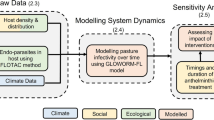Abstract
Since it was first detected in 1999, West Nile virus (WNV) quickly spread, becoming the dominant vector-borne disease in North America. Sometimes fatal to humans, WNV is even more widespread among birds, with hundreds of species known to be susceptible to WNV infection in North America alone. However, despite considerable mortality and local declines observed in American crows (Corvus brachyrhynchos), there has been little evidence of a large regional association between WNV susceptibility and population declines of any species. Here we demonstrate a correlation between susceptibility to WNV measured by large-scale testing of dead birds and two indices of overall population change among bird species following the spread of WNV throughout California. This result was due primarily to declines in four species of Corvidae, including all species in this family except common ravens (Corvus corax). Our results support the hypothesis that susceptibility to WNV may have negative population consequences to most corvids on regional levels. They also provide confirmation that dead animal surveillance programs can provide important data indicating populations most likely to suffer detrimental impacts due to WNV.

Similar content being viewed by others
References
Bonter DN, Hochachka WM (2003) Declines of chickadees and corvids: possible impacts of West Nile virus. American Birds 57:22–25
Brault AC, Langevin SA, Bowen RA, Panella NA, Biggerstaff BJ, Miller BR, et al. (2005) Differential virulence of West Nile strains for American crows. Emerging Infectious Diseases 10:2161–2168
Caffrey C, Smith SCR, Weston TJ (2005) West Nile virus devastates an American crow population. Condor 107:128–132
Caffrey C, Weston TJ, Smith SCR (2003). High mortality among marked crows subsequent to the arrival of West Nile virus. Wildlife Society Bulletin 31:870–872
CDC (2006) West Nile virus. Available: http://www.cdc.gov/ncidod/dvbid/westnile/ [accessed January 11, 2006]
CDHS (2006) West Nile virus activity in California Counties 2004 YTD. Available: http://www.westnile.ca.gov/2004_maps.htm [accessed November 1, 2006]
Dhondt AA, Badyaev AV, Dobson AP, Hawley DM, Driscoll MJL, Hochachka WM, et al. (2006) Dynamics of mycoplasmal conjunctivitis in the native and introduced range of the host. EcoHealth DOI: 10.1007/s10393-10006-10019-10397
Estrada-Franco J, Navarro-Lopez R, Beasley DWC, Coffey L, Carrara A-S, Travassos da Rosa A, et al. (2003) West Nile virus in Mexico: evidence of widespread circulation since July 2002. Emerging Infectious Diseases 9:1604–1607
Grinnell J, Miller AH (1944) The distribution of the birds of California. Pacific Coast Avifauna 27:1–608
Hayes EB, Gubler DJ (2006) West Nile virus: epidemiology and clinical features of an emerging epidemic in the United States. Annual Review of Medicine 57:181–194
Hochachka WM, Dhondt AA (2000) Density-dependent decline of host abundance resulting from a new infectious disease. Proceedings of the National Academy of Sciences of the United States of America 97:5303–5306
Hochachka WM, Dhondt AA, McGowan KJ, Kramer LD (2004) Impact of West Nile virus on American crows in the northeastern United States, and its relevance to existing monitoring programs. EcoHealth 1:60–68
Hom A, Bonilla D, Kramer V, Cahoon B, Barker C, Glaser C, et al. (2005) Surveillance for mosquito-borne Encephalitis virus activity and human disease, including West Nile virus in California. Proceedings and Papers of the 74th Annual Conference of the Mosquito and Vector Control Association
Kauffman EB, Jones SA, Dupuis AP, Ngo KA, Bernard KA, Kramer LD (2003) Virus detection protocols for West Nile virus in vertebrate and mosquito specimens. Journal of Clinical Microbiology 41:3661–3667
Kilpatrick AM, Kramer LD, Jones MJ, Marra PP, Daszak P (2006) West Nile virus epidemics in North America are driven by shifts in mosquito feeding behavior. PLoS Biology 4:e82
Klenk K, Snow J, Morgan K, Bowen R, Stephens M, Foster F, et al. (2004) Alligators as West Nile virus amplifiers. Emerging Infectious Diseases 10:2150–2155
Koenig WD, Liebhold AM (2005) Effects of periodical cicada emergences on abundance and synchrony of avian populations. Ecology 86:1873–1882
Komar N (2003) West Nile virus: epidemiology and ecology in North America. Advances in Virus Research 61:185–234
Komar N, Langevin S, Hinten S, Nemeth N, Edwards E, Hettler D, et al. (2003) Experimental infection of North American birds with the New York 1999 strain of West Nile virus. Emerging Infectious Diseases 9:311–322
Lanciotti RS, Roehrig JT, Deubel V, Smith J, Parker M, Steele K, et al. (1999) Origin of the West Nile virus responsible for an outbreak of encephalitis in the northeastern United States. Science 286:2333–2337
Marra PP, Griffing S, Caffrey C, Kilpatrick AM, McLean R, Brand C, et al. (2004) West Nile virus and wildlife. BioScience 54:393–402
Reisen W, Lothrop H, Chiles R, Madon M, Cossen C, Woods L, et al. (2004) West Nile virus in California. Emerging Infectious Diseases 10:1369–1378
Sauer JF, Peterjohn BG (1994) Observer differences in the North American breeding bird survey. Auk 111:50–62
Stone WB, Therrien JE, Benson R, Kramer L, Kauffman EB, Eidson M, et al. (2005) Assays to detect West Nile virus in dead birds. Emerging Infectious Diseases 11:1770–1773
Yaremych SA, Warner RE, Mankin PC, Brawn JD, Raim A, Novak R (2004) West Nile virus and high death rate in American crows. Emerging Infectious Diseases 10:709–711
Zahn SN, Rothstein SI (1999) Recent increase in male house finch plumage variation and its possible relationship to avian pox disease. Auk 116:35–44
Acknowledgments
We thank W. Hochachka, A. Dhondt, and the reviewers for comments and suggestions. Support for W.D.K. and J.L.D. came from the National Science Foundation.
Author information
Authors and Affiliations
Corresponding author
Rights and permissions
About this article
Cite this article
Koenig, W.D., Marcus, L., Scott, T.W. et al. West Nile Virus and California Breeding Bird Declines. EcoHealth 4, 18–24 (2007). https://doi.org/10.1007/s10393-007-0086-4
Received:
Accepted:
Published:
Issue Date:
DOI: https://doi.org/10.1007/s10393-007-0086-4




